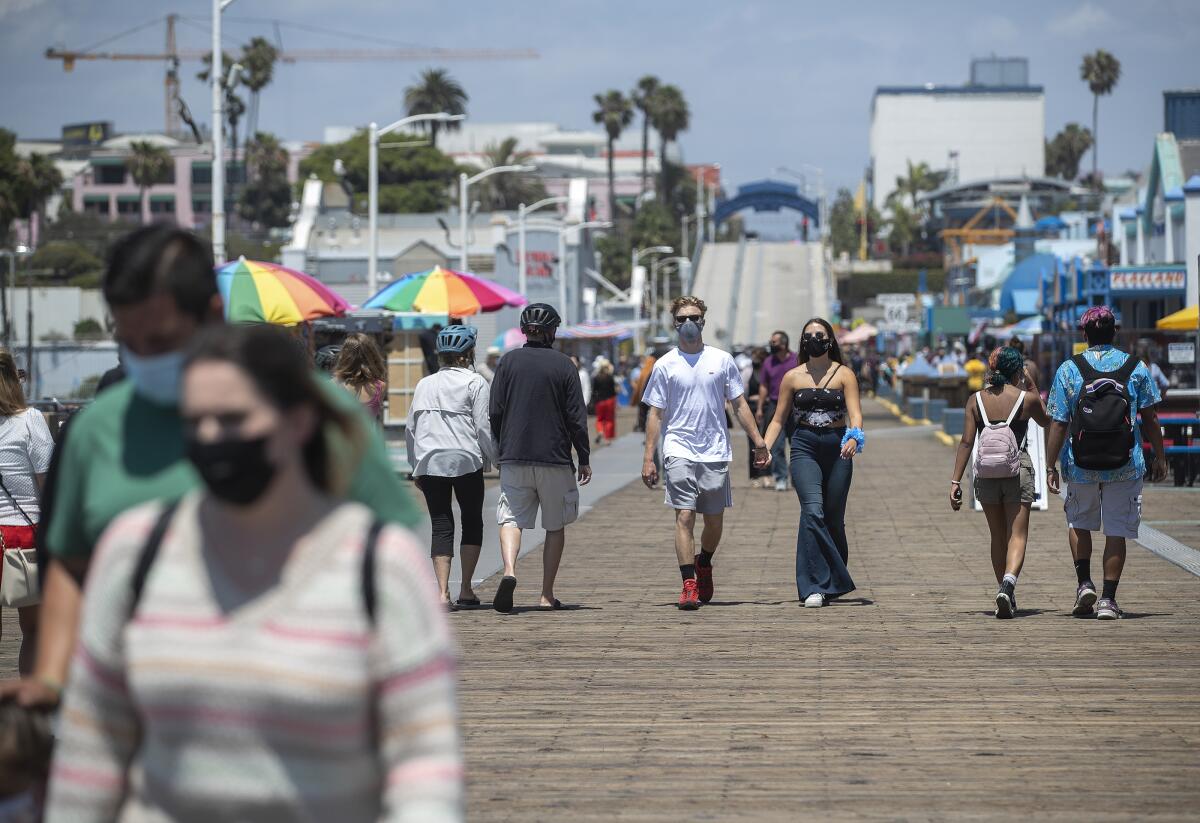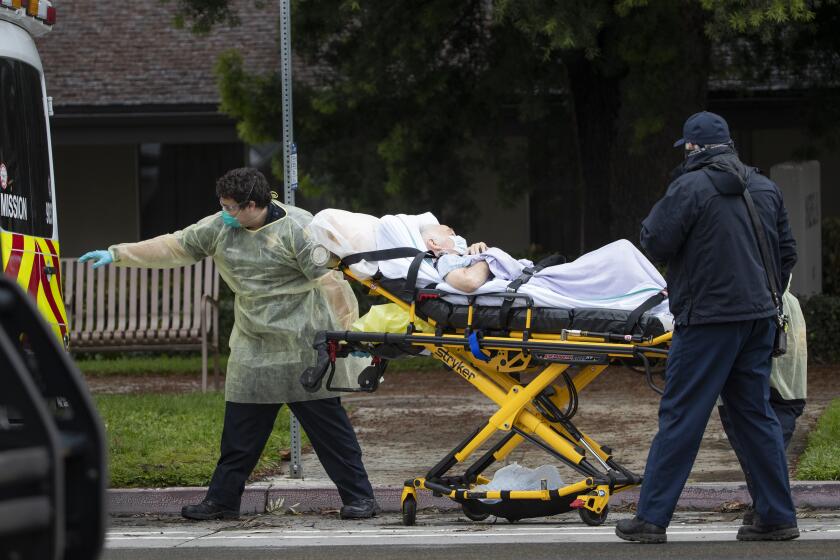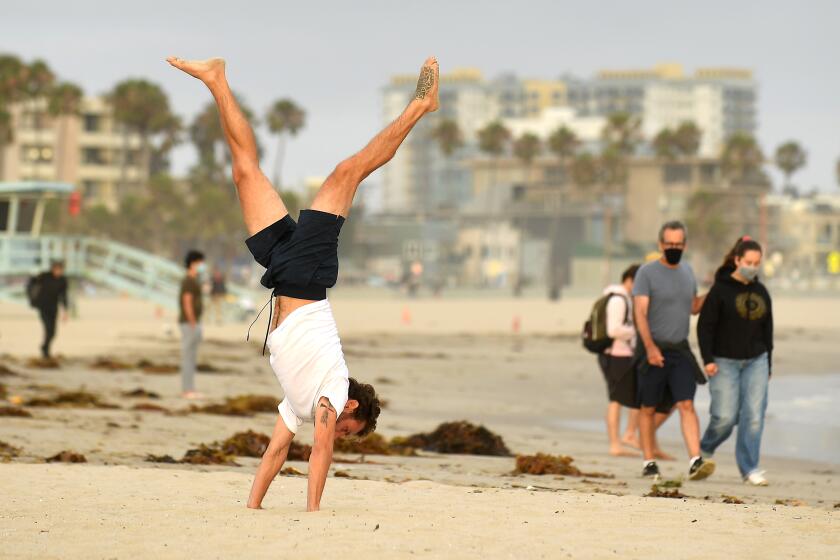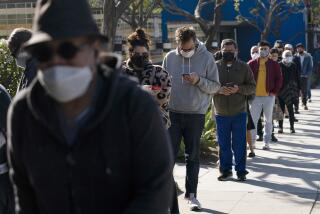‘We’re surging again.’ Doctors, nurses angry as coronavirus strains California hospitals

- Share via
For a brief moment, California returned to bars, beaches and Botox. But after a few days, much of the state is reversing course as hospitals see an alarming spike in people sick with COVID-19, raising the specter of an overwhelmed medical system.
“It’s scary,” said Peter Chin-Hong, an infectious disease expert at UC San Francisco. “We still haven’t recovered from the first phase, and now we have to get ready for the next one.”
While Chin-Hong and other medical experts said California currently has the capacity it needs to treat patients, the future is uncertain. Coronavirus cases jumped to more than 220,000 Monday, creeping steadily upward in some places, skyrocketing in others and prompting health officials in multiple counties to demand the closure of bars, hair salons and other businesses opened only days ago.
Gov. Gavin Newsom said hospitalizations have increased 43% in the last two weeks while admissions to ICU units have increased 37%. He hinted at stricter statewide action if counties were unable to contain outbreaks.
“We don’t like the trend line,” Newsom said. “Let me be forthright with you: We are considering a number of other things to advance, and we will be making those public as conditions change.”
Some of the worst outbreaks are in Imperial and Riverside counties, where ICU beds are nearly full and nurses at one hospital have gone on strike to protest what they say is understaffing and a lack of protective gear.
While Riverside County’s ICU beds are nearly all taken, partly because of the coronavirus, the bigger challenge for health authorities is a staffing shortage.
“When you deliberately don’t staff someone to relieve me, I have to stay on duty,” said Erik Andrews, a nurse at Riverside Community Hospital. “Our professionalism is being exploited.”
Hospital officials denied that they were low on staff or protective gear, but the overwhelming case load in the area prompted Rep. Raul Ruiz (D-Palm Desert), an emergency room physician, to call for a reinstatement of restrictions and mask wearing.
California officials have said that hospitalizations should not increase by more than 10% over any three days, but more than a dozen counties across the state are missing the mark. California has about 7,880 ICU beds, and about 38% currently are in use by non-COVID patients, according to Covid Act Now, a collaboration between Stanford and Georgetown universities.
As government officials struggled to regain control of residents weary of restrictions and eager to celebrate the upcoming Fourth of July holiday, numerous health officials are frustrated and fearful. Many said that while hospital capacity has increased, and more is known about how to treat the disease, those on the front lines still face shortages, stress and chagrin that the public is not taking precautions.
One emergency room physician in Los Angeles County contacted a Times reporter on Monday by sending a two-word text message: “Déjà vu.”
“I’m not sure why everyone is so surprised that we’re surging again. It never went away, and we opened up” while mask-wearing was being “politicized,” the physician said, calling it “very frustrating.”
Erin McIntosh, 37, a rapid response nurse in the Inland Empire said the last few months had been the “worst of the worst.”
“It leaves us feeling in like we’re not enough,” McIntosh said. “I feel like this is all setting us up to fail.”
But public resistance to restrictions also remains strong, making it difficult to re-institute public health protections, said some experts.
“Every single one of those county health officers faces an impossible set of circumstances,” said David Relman, a Stanford doctor.
Unlike with the first days of the epidemic, when much of the virus was concentrated in urban areas, infections are now rising in California’s northern and inland counties, putting pressure on medical systems with fewer resources. It has left some medical experts to warn the state is not experiencing a second wave, but a failure to maintain the flattened curve of the first one.
And the virus continues to take an uneven toll, hitting communities of color and the elderly hardest, and often leaving the young and more affluent with milder cases that are diagnosed and treated earlier.
A study by Sutter Health in May found that Black COVID-19 patients in Northern California were nearly three times more likely to be hospitalized than non-Hispanic white patients and arrived at the hospital with more severe symptoms. Black patients also die of COVID-19 at higher rates, according to the study and state data.
Stephen Lockhart, chief medical officer for Sutter, said he believes those disparities will continue, in part because people of color make up a larger percentage of the essential workforce, can’t afford to stay home when they become ill and often live in multigenerational settings where the infection is passed to others.
“It’s very obvious that COVID-19 has sort of ripped the Band-Aid off the existing inequities,” Lockhart said.
Epidemiologists say it’s not yet clear whether the surge in cases will cause a similar increase in deaths. Many of the newest infections are younger individuals. And treatments have improved survival rates, said medical experts.
But one model, by Covid Act Now, predicts deaths in California could hit 24,000 in the next month based on current trends. Currently, about 5,900 Californians have died from causes related to COVID-19.
Newsom said the stay-at-home order put in place in March bought time to prepare for coming cases, including surge sites that were closed weeks ago but could be re-opened.
The governor said the state has about 30,000 hospital beds available for COVID-19 patients in the traditional hospital system, including about 3,300 available ICU beds.
As of Monday, he said 4,776 people were hospitalized with a confirmed case of the virus.
Only a day after California recorded its highest single-day count of coronavirus cases — more than 8,000 infections — the state’s death toll surpassed 6,000.
“So numbers are going up, but our ability to manage and absorb also is significant,” Newsom said.
But those beds are unevenly distributed throughout the state. Newsom said Imperial County, which has experienced positivity rates of 23%, has exceeded its hospital capacity.
“Over a five-week period, just a five-week period, we had to move 500 patients out of their hospital system into surrounding county systems,” Newsom said.
In Los Angeles, there are signs that cases could overload local facilities if not curtailed.
“While we did anticipate increases in cases as sectors reopened, we did not expect the increases to be this steep this quickly,” Barbara Ferrer, the public health director in LA County, said Friday.
San Francisco and the Bay Area are also experiencing a “surge” in COVID-19 rates of infection and the city will have to “pause” its reopening, the city’s health director said Friday. The seven-day average number of COVID-19 patients in hospitals in Contra Costa County rose 75% from June 15 to June 29, the county reported Monday.
Businesses that were scheduled to reopen on Monday will now stay closed, Health Director Grant Colfax said.
“We went we went from a yellow to a high orange, and if that continues over the next couple of days, we could be in our red zone,” which could trigger more restrictions, he said. “Our curve is not flat right now. ... In fact, that curve is getting more and more vertical.”
Health officials are also alarmed by large outbreaks in California’s prisons and jails. At San Quentin, just north of San Francisco, more than 1,000 inmates have tested positive. Facilities in Fresno, Lassen County and Riverside also have outbreaks, as do numerous county jails. Health officials said those patients likely will end up being treated in community hospitals if their cases become severe, adding another point of pressure.
“The prison system doesn’t have that level of care for prisoners, so when they start doing really badly, we have to take them in the community,” said Chin-Hong, the UC San Francisco doctor.
Health experts said that the rising numbers will continue without the kinds of social interventions put in place during the first days of the pandemic. If the spread isn’t stopped soon, they warn, it may become impossible.
“It could get to some point where there literally is just too much disease to manage,” Relman said.
Times staff writer Maura Dolan contributed to this report.
More to Read
Sign up for Essential California
The most important California stories and recommendations in your inbox every morning.
You may occasionally receive promotional content from the Los Angeles Times.



















